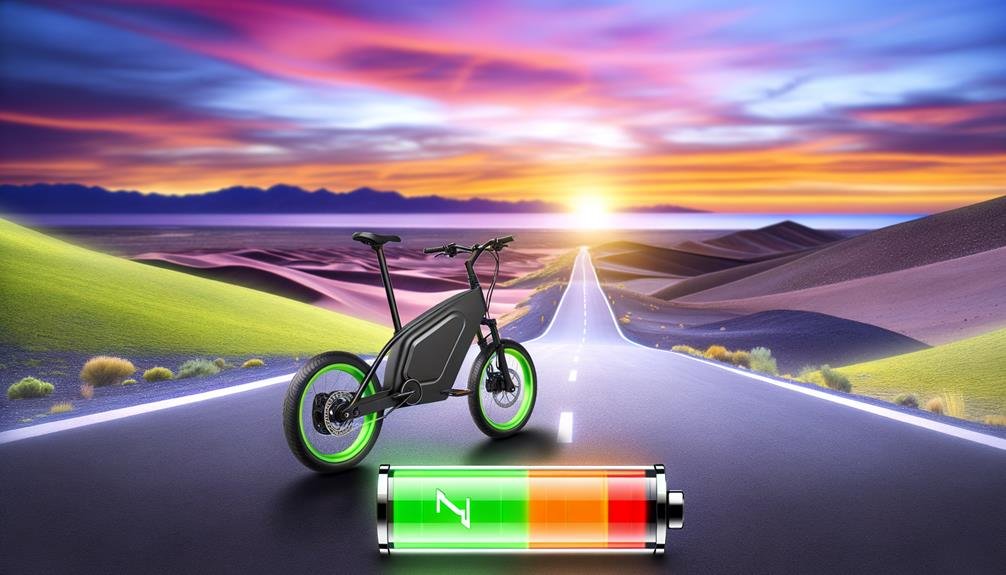Charles Miller is a veteran bike enthusiast with over 12 years of experience dealing with bikes as a mechanic. Despite immense love and expertise for...
In recent years, a significant shift has been observed in transportation preferences, with electric bikes (e-bikes) emerging as a prominent player in the market.
As an amalgamation of the traditional cycling experience and modern, energy-efficient technology, e-bikes have been lauded for their potential in catalyzing a new era of sustainable commuting. However, it is essential to critically analyze and understand the multifaceted impact of this innovation.
In this discussion, we will explore the tangible and intangible differences an e-bike can make, including its effects on health, environment, economy, and overall lifestyle.
Are these differences substantial enough to warrant the switch from conventional bikes or other modes of transport?
Let's unpack this together.
- Key Takeaways
- Understanding Electric Bikes
- Comparing Riding Experiences
- Assessing Speed Differences
- Overview of Rules and Regulations
- Choosing the Right E-Bike
- Real Life Comparisons: E-Bike Vs Regular Bike
- Ten Advantages of E-Bikes
- Disadvantages and Considerations
- Reader Interactions and Feedback
- Frequently Asked Questions
- Conclusion
Key Takeaways
- Electric bikes (e-bikes) provide additional power when pedaling, allowing for longer distances and easier tackling of challenging terrains.
- E-bike riders have higher exercise minutes and longer trip distances compared to regular bikers, contributing to improved fitness levels and reduced carbon footprint.
- E-bikes offer faster speeds, averaging around 15 to 20 miles per hour, and can maintain this speed for longer distances, increasing efficiency.
- Riding an electric bike empowers and includes riders, going beyond being just a mode of transport and creating a sense of belonging to a community that values fitness and environmental consciousness.
Understanding Electric Bikes
What distinguishes electric bikes, commonly known as e-bikes, from conventional bicycles? The key difference lies in the electrical drive system, which powers the motor, and the pedal assistance feature that an electric bike offers. Understanding electric bikes involves recognizing how these two elements work in harmony to create a unique biking experience.
When one pedals an e-bike, the motor kicks in, providing additional power to the bicycle's movement. This pedal assistance feature allows riders to cover longer distances and tackle challenging terrains with less effort compared to a conventional bike. The e-bike's electrical drive system is typically powered by a rechargeable battery, contributing to their eco-friendly nature.
Moreover, the flexibility offered by e-bikes has been found to encourage higher exercise minutes and longer trip distances. E-bikes are not just suitable for various types of trips, but also for different individuals, regardless of age or fitness level. This inclusivity challenges stereotypes and misconceptions about biking. The use of an electric bike, therefore, is not just a choice of convenience but also one of significant health and environmental benefits.
Comparing Riding Experiences
Building upon the understanding of electric bikes, it becomes crucial to juxtapose the riding experiences of e-bike users with those of conventional bikers to further elucidate the unique advantages of this technological advancement.
When comparing riding experiences, it's evident that riding an e-bike provides certain advantages over riding regular bikes. E-bike riders, for instance, have a higher number of exercise minutes and longer trip distances. This demonstrates that Electric Bikes vs Regular Bikes offer similar or even higher activity levels. It's a common misconception that e-bikes provide less of a workout, but e-bike riders report otherwise.
E-bikes also permit longer and more frequent trips. The average daily travel distance of an e-bike user surpasses that of a conventional cyclist, proving the question of how much difference does an electric bike make is significant.
Furthermore, riding an e-bike contributes to reducing the carbon footprint and increasing fitness levels when replacing car trips. This gives e-bike users a sense of belonging to a community that values fitness and environmental consciousness.
Assessing Speed Differences

The speed differences between electric bikes and traditional bikes is a crucial aspect to consider when assessing their overall impact and usability.
In our analysis, we will compare the average speed of e-bikes to that of conventional bikes, and evaluate how these variations affect commuting times and efficiency.
This objective comparison offers insight into the practical value of e-bikes in various commuting scenarios.
Understanding Electric Bike Speed
Delving into the realm of electric bike speed, it's noteworthy that e-bikers often report significantly longer trip distances compared to traditional cyclists, suggesting a marked difference in speed and efficiency.
Riding an electric bike allows you to ride faster, averaging speeds of around 15 to 20 miles per hour, a substantial increase compared to standard bicycles. The e-bike's display screen conveniently shows your speed, allowing for constant monitoring and adjustment.
The efficiency of an e-bike is not just about the speed, but also the ability to maintain this speed for longer distances. This encouraging efficiency can inspire a sense of belonging within the e-bike community, challenging stereotypes and misconceptions.
Therefore, an electric bike is not just a mode of transport, but a tool for empowerment and inclusion.
Comparing E-bike and Traditional
In light of the enhanced speed capabilities of e-bikes, it becomes crucial to comparatively assess their performance against traditional bicycles, particularly in terms of trip duration and distance covered.
When comparing e-bike and traditional bike riding, several differences emerge:
- E-bike riders often cover longer distances than regular bike users.
- The physical activity level on an electric bike is comparable, if not higher, to that of regular bikes.
- Electric bikes make longer and more frequent trips possible, broadening the scope of cycling.
- Riding an e-bike contributes to a reduction in carbon footprints, while also promoting fitness.
Thus, the difference an electric bike makes is evident in terms of speed, distance, and overall riding experience, challenging traditional biking norms.
Speed Influence on Commuting
Significantly, the influence of speed on commuting patterns reveals a distinct advantage for e-bike riders, who frequently exhibit higher exercise minutes and longer trip distances compared to their traditional biking counterparts.
As they commute to work, the speed influence on commuting is evident. Electric bike use allows for quicker travel times, reducing commuting duration and potentially decreasing overall transportation costs.
Moreover, e-bike riders can maintain similar or even higher activity levels compared to regular bikes, defying common misconceptions. This ability to take on longer and more frequent trips not only makes e-bikes an efficient commuting option but also contributes to reduced carbon footprints and enhanced fitness levels.
Therefore, e-bikes significantly challenge the conventional commuting norms, inviting a sense of belonging for all riders.
Overview of Rules and Regulations

The rules and regulations associated with electric bikes are multifaceted and can vary based on several factors, such as the bike's class or the state it's operated in. Legislation plays a crucial role in defining speed and power limitations, as well as safety precautions like helmet use or rider's age.
Additionally, while some e-bike classes may not necessitate a permit or insurance, it's imperative to verify local rules to understand where and how these vehicles can be used.
Understanding E-bike Legislation
Navigating the legislative landscape for e-bikes often involves understanding specific state regulations, which can include speed and power limitations, helmet use, and minimum age requirements for riders. This is a crucial step before deciding to use an e-bike instead of a traditional bike.
Understanding e-bike legislation can be simplified by considering the following points:
- Different states have unique e-bike legislation that controls speed and power limitations.
- Helmet use and minimum age for riders can also vary by states.
- The class of the e-bike significantly impacts the regulations.
- Always check with local authorities about where you can ride your e-bike.
Importance of Safety Guidelines
Comprehending the importance of safety guidelines in relation to e-bikes demands a meticulous examination of the applicable rules and regulations that govern their use. E-bikes, unlike regular bikes, are subject to additional government regulations, such as speed and power limitations. These regulations are necessary to ensure the safety of both electric bike riders and other road users.
The class of the electric bike can also influence the specific rules applied. Notably, Class I, II, and III electric bikes offered by some manufacturers do not require a permit or insurance. However, local conditions may necessitate adherence to guidelines such as helmet use or minimum age requirements.
Hence, for a safe ride, understanding and following these safety guidelines is crucial.
Choosing the Right E-Bike
Given the numerous benefits e-bikes offer, such as higher exercise minutes, longer trip distances, and increased physical activity, making an informed decision when selecting the right e-bike becomes crucial. When choosing the right e-bike, several factors play a significant role.
- Purpose: Are you planning to use your new bike for daily commuting or weekend rides? Remember, electric bikes are versatile and can serve various purposes.
- Budget: E-bikes come at different price points. While they could be more expensive than regular bicycles, the major difference in the quality of ride e-bikes offer is often worth the extra cost.
- Comfort and Fit: Ensure the e-bike you choose provides a comfortable ride and fits you well. Unlike regular bikes, a poorly fitting e-bike can affect both your ride and the bike's performance.
- Range and Speed: Depending on your needs, choose an e-bike that provides the right balance of range and speed. Some e-bikes can travel up to 50 miles on a single charge at speeds of up to 20 mph.
Real Life Comparisons: E-Bike Vs Regular Bike

Having considered the factors involved in choosing an e-bike, it is essential to explore real-life comparisons between e-bikes and regular bikes to gain a comprehensive understanding of their distinctive benefits and uses. The electric bike, powered by an electric motor, presents distinctive advantages over a regular bike, particularly in terms of enhanced mobility and increased fitness levels.
| Electric Bike | Regular Bike | |
|---|---|---|
| Exercise Minutes | Higher | Lower |
| Trip Distance | Longer | Shorter |
| Mobility Options | More diverse | Less diverse |
| Carbon Footprint | Lower | Higher |
Real life comparisons show that e-bike riders have higher exercise minutes and longer trip distances. This fact challenges common misconceptions about e-bikes and sheds light on how much difference an e-bike can make. E-bikes can be used for longer and more frequent trips, proving their utility beyond being merely a leisurely ride. They offer a complementary mobility option for various types of trips, thus fostering a sense of belonging and inclusivity among riders. More importantly, e-bikes contribute to reducing carbon footprint, thereby making a significant difference to our environment. These comparisons serve to underscore the value and versatility of the e-bike against the regular bike.
Ten Advantages of E-Bikes
Delving into the numerous benefits of e-bikes, it becomes apparent that they offer ten distinct advantages, providing a unique blend of improved fitness, increased mobility, and environmental sustainability, while also challenging prevailing misconceptions about their utility and versatility. E-bikes become not just a mode of transport, but a tool for change, creating much difference in our day-to-day lives.
Here are the four key benefits that underscore the ten advantages of e-bikes:
- E-bikes promote increased fitness. Riders have been observed to exercise longer and travel further than those using conventional bikes.
- Enhanced mobility is another distinct advantage. E-bikes allow for longer and more frequent trips, broadening our range of movement.
- Riding E-Bikes contribute significantly to environmental sustainability. They reduce our carbon footprint, supporting a greener planet.
- E-bikes challenge stereotypes. They are suitable for a diverse range of individuals, regardless of age or fitness level, making them a versatile choice.
In essence, the electric bike revolution is not just about speed and convenience. It's about creating a sense of belonging, a healthier lifestyle, and a more sustainable world. Truly, the difference that E-Bikes Make is substantial and transformative.
Disadvantages and Considerations

While e-bikes offer numerous advantages, it is crucial to consider certain drawbacks and factors, including their high initial cost, lower environmental efficiency compared to traditional bicycles, and the practical challenges associated with their weight and maintenance.
The significant difference in price between e-bikes and regular bikes can be a substantial barrier to entry for many. E-bikes also require maintenance to annual repairs, making them less convenient for those who desire low-maintenance transportation.
Additionally, their environmental efficiency is lower than that of traditional bikes, largely due to their manufacturing process and the electricity required to charge them. This is a key disadvantage and consideration for environmentally conscious consumers.
Moreover, the weight of e-bikes can complicate transportation and storage. Their heavy build, coupled with the need for regular battery charging, increases the importance of taking care when transporting or storing them.
Lastly, a warranty that should cover repairs and parts is a critical consideration. This can mitigate some maintenance costs, but it's essential to read the fine print to understand what it includes and excludes.
Ultimately, these considerations will help potential buyers decide whether an e-bike is a suitable investment for them.
Reader Interactions and Feedback
In light of feedback and interactions from e-bike riders, research published in Transportation Research Interdisciplinary Perspectives reveals that these users report higher exercise minutes and longer trip distances compared to traditional cyclists. This might be due to the pedal assist feature in electric bikes that make it easier for riders to cover longer distances, thereby increasing their exercise minutes.
The assistance from the motor doesn't necessarily mean less physical effort. In fact, users of electric bikes have shared:
- They tend to opt for electric bike rides over car trips, thereby reducing their carbon footprint.
- They find themselves cycling longer distances than they would on regular bikes, which inadvertently increases their overall physical activity.
- The pedal assist feature on electric bikes makes it easier for them to tackle hilly terrains, making cycling more enjoyable and less strenuous.
- They believe electric bikes are inclusive, catering to diverse age groups and fitness levels.
In essence, electric bikes seem to have an edge over regular bikes in boosting physical activity and promoting eco-friendly commuting, as reflected in the feedback from users.
Frequently Asked Questions
Do Electric Bikes Make a Difference?
Electric bikes, with their affordability, advanced technology, and easy maintenance, significantly impact commuting convenience. They are environmentally friendly, thus reducing carbon footprint, and promote increased physical activity, enhancing health benefits for riders.
Is It Worth It to Have an Electric Bike?
An electric bike's durability, cost-effectiveness, health benefits, and environmental impact make it a worthy investment. Their versatility and low maintenance needs cater to various user needs, promoting inclusivity and a sense of belonging among riders.
How Much Quicker Is an Electric Bike to a Normal Bike?
The speed comparison between electric and traditional bikes shows that e-bikes are faster due to their power to weight ratio. Efficiency analysis and energy consumption studies confirm a superior riding experience with electric bikes.
What Are the Disadvantages of Ebikes?
Electric bikes present disadvantages such as high cost, frequent battery replacement, limited range, heavy weight, long charging times, and regular maintenance. These factors could potentially offset the benefits they offer in terms of speed and ease of use.
Conclusion
In conclusion, the transformative potential of e-bikes as a sustainable and fitness-friendly mode of transportation is significant. A study revealed that e-bike riders tend to log more exercise minutes per week, thus boosting fitness levels.
However, it is essential to understand the rules and regulations, and consider personal needs before investing in an e-bike. Addressing misconceptions, e-bikes can indeed be a viable, eco-friendly alternative to conventional bikes.

Charles Miller is a veteran bike enthusiast with over 12 years of experience dealing with bikes as a mechanic. Despite immense love and expertise for his Tacoma, he rides his Trek Ebike more. Anytime you meet him, you’ll either hear him talking about Bikes, or writing about all things bikes and cars on this blog.
More Posts


